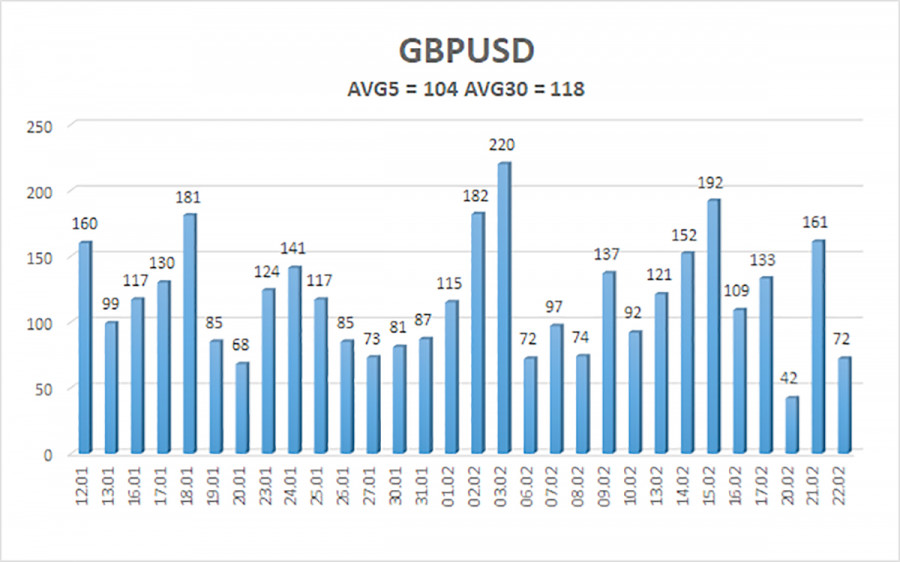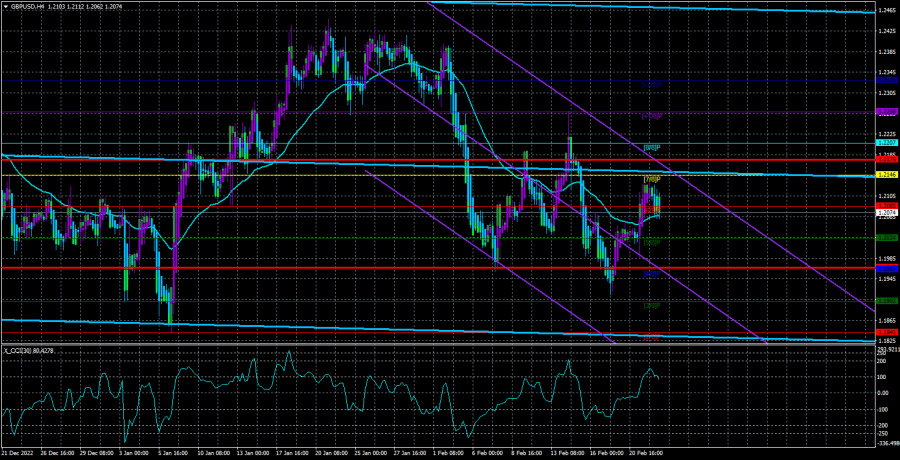On Tuesday and Wednesday, the GBP/USD currency pair was able to surge upward and return to the moving average line. As a result, the pound sterling is now moving differently from the euro, but it also tends to decline. In the UK, reports on business activity were released on Tuesday, (when it occurred), although they weren't the most crucial ones. Despite this, the actual results were substantially better than expected. They were the ones who caused the British pound to increase significantly, although we had not anticipated such a drastic change. But, comparable things do occasionally occur, so you should also be ready for this. Nobody can predict in advance what a certain report will be worth. Hence, strictly speaking, we are currently in an upward trend. But, it may end very fast because the pair is generally moving lower; the only upward pullbacks (without which it is impossible to do so) are rather substantial. These rollbacks allow the pair to frequently overcome the movement.
The primary concern for the British currency is still rates. Therefore, if the Fed rate makes everything more or less plain, the BA rate makes nothing clear. The British regulator continues tightening by 0.5% at each meeting, and the rate has now increased to 4%. How long will this aggressive attitude last, though? The Fed rate peaked at about 5%, and the Bank of England is not likely to go above that level. As a result, there will only be one meeting where the increase is less than 0.5%, after which the rate of tightening will begin to slow down once more. Yet, inflation is already 6.4% in the United States and above 10% in the UK. For instance, James Bullard believes that this year could see a return to an increase in inflation. In general, nothing about inflation or rates is made explicit until the very end.
We have already mentioned countless times how upset British citizens are with Brexit. As this was precisely the aegis under which Brexit was positioned, many of them likely anticipated an improvement in the nation's economic status. Recall that London wanted to escape the jurisdiction of Brussels, and at the same time not pay hefty membership costs to the European budget. Nonetheless, even in 2016, the number of people who supported leaving the EU over those who opposed it by a mere 4%. This gap got smaller every year until it started getting wider. Many Britons now express remorse about the nation's decision to leave the EU. The British have gone through a terrible pandemic, in which the government hasn't always been on their side, multiple political crises, and now there's considerably more inflation than in the EU, a possible economic downturn, and increased taxes. Understandably, the British are starting to regret leaving the Alliance, and Rishi Sunak publicly states that he will disregard the outcomes of the 2016 referendum and pursue rapprochement with the EU.
It's interesting to note that in the EU nations, support for potential new "Brexits" has drastically diminished. In other words, if a given proportion of residents in a particular nation favored leaving the EU, that proportion has significantly decreased. Strangely enough, the EU has become more unified since the UK left. The effects of British disintegration, which is currently wanted in Britain itself, are seen by the entire world. Yet Scotland has been giving London deadlines on its wish to have a referendum, break away from the United Kingdom, and rejoin the EU for many years. But it must be acknowledged that throughout the past 25 years, there haven't been many people who have wanted to leave the EU in practically all of the member states. In 2016–2017, this percentage increased to 30% in Finland alone. For instance, in France, the percentage of departure supporters during that time did not get above 10%. So, potential "Brexit supporters", like France or Italy, suddenly have far less likelihood of support from the population. Hungary, whose leader does not appeal to many people in the European Union, is currently most at risk.

Over the previous five trading days, the GBP/USD pair has experienced an average volatility of 104 points. This number is the "average" for the dollar/pound exchange rate. So, we anticipate movement inside the channel on Thursday, February 23, with movement being limited by levels of 1.1967 and 1.2175. The Heiken Ashi indicator's upward reversal will indicate when the upward movement has resumed.
Nearest levels of support
S1 – 1.2024
S2 – 1.1963
S3 – 1.1902
Nearest levels of resistance
R1 – 1.2085
R2 – 1.2146
R3 – 1.2207
Trade Suggestions:
In the 4-hour timeframe, the GBP/USD pair is once again above the moving average. Consequently, in the event of an upward reversal of the Heiken Ashi indicator or a rebound from the downward trend, we may now think about long positions with targets of 1.2146 and 1.2175. If there is a consolidation below the moving average, long positions can be opened with targets of 1.2024 and 1.1963.
Explanations of the illustrations:
Determine the present trend with the use of linear regression channels. The trend is now strong if they are both moving in the same direction.
Moving average line (settings 20.0, smoothed): This indicator identifies the current short-term trend and the trading direction.
Murray levels serve as the starting point for adjustments and movements.
Based on current volatility indicators, volatility levels (red lines) represent the volatility levels. The volatility levels (red lines) represent the likely price channel where the pair will likely spend the next day.
A trend reversal in the opposite direction is imminent when the CCI indicator crosses into the overbought (above +250) or oversold (below -250) zones.























